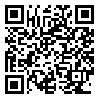BibTeX | RIS | EndNote | Medlars | ProCite | Reference Manager | RefWorks
Send citation to:
URL: http://rjms.iums.ac.ir/article-1-642-en.html
Background & Aim: Peroneal reaction time measurement has been used to objectively evaluate functional instability of the ankle joint. The reliability of the method has been reported only in frontal plane, but it has not been proven in oblique plane. The purpose of this study was to determine the reliability of ankle musculature latency, peak and time of activation measurements on a tilting platform(APS=Ankle Perturbation System) in response to sudden external oblique perturbation under different conditions. Patients & Method: The latency, peak and time of activation of 10 healthy and 10 unhealthy subjects with functional ankle instability(FAI) were examined in a methodological study. The latency, peak and time of activation after sudden inversion of the ankle were determined by APS and surface EMG(Electromyography). Relative reliability(1&1 model) and absolute reliability(Standard Error of Measurement) were used as statistical methods. Results: The ranges of ICC(Intra-class Correlation Coefficient) values for latency of Peroneus Longus(0.97-0.99), Tibialis Anterior(0.92-0.99), Peroneus Brevis(0.96-0.99), and Soleus(0.98-0.99) for 10, 20, and 30 degrees of oblique Plane were obtained. These values for peak of activation of Peroneus Longus(0.92-0.99), Tibialis Anterior(0.97-0.99), Peroneus Brevis(0.95-0.99), Soleus(0.96-0.99) and for time of activation of Peroneus Longus(0.95-0.99), Tibialis Anterior(0.94-0.99), Peroneus Brevis(0.91-0.99), and Soleus(0.9-0.99) were calculated too. The ranges of SEM(Standard Error of Measurement) values for latency of Peroneus Longus(0.76-2.06), Tibialis Anterior(0.91-3.15), Peroneus Brevis(0.89-1.72), and Soleus(0.67-1.22) were also obtained. These values for peak of activation of Peroneus Longus(2.98-10.82), Tibialis Anterior(3.51-4.58), Peroneus Brevis(3.4-4.23), Soleus(4.27-10.05) and for time of activation of Peroneus Longus(2.4-6.81), Tibialis Anterior(2.66-9.19), Peroneus Brevis(3.87-14.75), and Soleus(4.25-17.67) were calculated as well. Conclusion: Determination of timing of muscle activity was proven as a reliable measurement technique.





